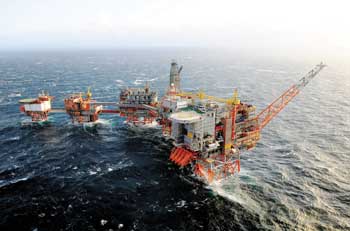Aluminium: the Perfect Solution for Many Structural Applications
An overview of the solutions provided by Bayards, a Dutch company founded over 50 years ago which developed a complex system of profilesand components for light, strong, durable, corrosion-resistant structures requiring no maintenance
by Alberto Pomari
Bayards is well-known worldwide for its vast range of light alloy offshore structures and is on the cutting edge of technology when it comes to developing complex projects with customized solutions for each client. The company knows and exploits fully the versatility of aluminium, a material which, thanks to its great engineering flexibility, allows to create structures up to 60% lighter than their steel equivalent. Aluminium resists the saline corrosion due to sea water and for this reason the light metal is the perfect solution for the offshore industry. Bayards is working along with such important contractors as Hyundai, Samsung, Daewoo and Keppel, involved, in partnership with outstanding engineering companies, in projects for such established companies as BP, Statoil, Shell, ONGC and Exxon Mobil.
Engineering creativity: from design to installation
Engineering is the starting point for Bayards’s technicians who use the most sophisticated design software, such as Tekla and STAAD, for a large number of applications including: helipads, offshore platforms, bridges and gangways, support structures, security nets, access systems, flex-barriers, swing load protection barriers, antenna towers, telescopic gangways, helicopter hangars, firefighting equipment, lighting systems, heat tracing, stair towers, living quarters, hand railings, wind and heat shields, safety gates and more.
Landing pads for helicopters
Bayards helipads stand out as the most prominent installations created by the Dutch company when it comes to innovative, smart solutions. Over 600 helipads have already been completed worldwide in such important sites as Milan’s Trade Fair grounds in Italy, the Royal London Hospital in England, the Queensland Children’s Hospital in Brisbane, Australia, the Exhibition
Centre in Barcelona, Spain and the Dresden University Hospital in Germany. These structures are equipped with lighting systems for night landing, fitted inside the flooring profiles. Another important optional is a heating system which makes use of aluminium’s good heat conduction properties, with three different systems which may be adopted according to the various situations. A first system uses electrical resistance, the second, channelled hot water, and the third exploits hot air in contact with the surfaces. The panels are welded together using the Friction Stir Welding technology for the best joining of the components, avoiding critical issues which would be possible with other technologies. The final result is a helipad which cuts down by one third the overall load which bears on the underlying structures.
Aluminium for the Oil&Gas Industry
Right up to the Nineties, steel was the reference material in the oil & gas industry, but today thanks to the numerous advantages which aluminium provides with respect to traditional materials, the industry’s demand for structures in light alloys I constantly on the increase. Aluminium structures are:
• up to 60% lighter than steel ones, offering a relevant weight saving and easy and cost-effective installation;
• very strong, suitable for sea water environments; even without protective coatings, they ensure durability;
• resistant to extreme environmental temperatures.
Aluminium for bridges and gangways
For this type of structures, the systems created by Bayards allow to create large structures for pedestrian bridges, gangways and fire stairs. 6000-class aluminium alloy profiles are initially longitudinally milled using work stations with multi-cut blades. This machining is carried out to ensure that the surfaces of the extrusions are not slippery and to prevent water from forming dangerous stagnant build-ups on the surface. Therefore, as said for helipads, it is possible to obtain light structures, aesthetically very pleasant and, even without special coatings and finishings, extremely durable.
Production technology and software
Bayards has a department with machines dedicated specifically to the production of aluminium constructions: in order to obtain the highest quality levels, the company uses such cutting-edge technologies as Friction Stir Welding, high speed and high precision (5 axes) milling, robotised welding. All the production is manufactured internally using state-of-the-art production software, including CATIA V5, CAMALEO-PUMA and Optiscout 7.
Bayards’s standards
When we talk about the offshore industry, QHSE requisites are extremely stringent. Bayards complies with the international ISO and OHSAS standards and on regulations concerning products, with a quality control system based on ISO 9001 and a production control in accordance with the EN-1090-1 regulation for CE marking (where applicable). Besides, there are procedures and policies regarding health, safety and the environment which are compliant with the current legislation.

